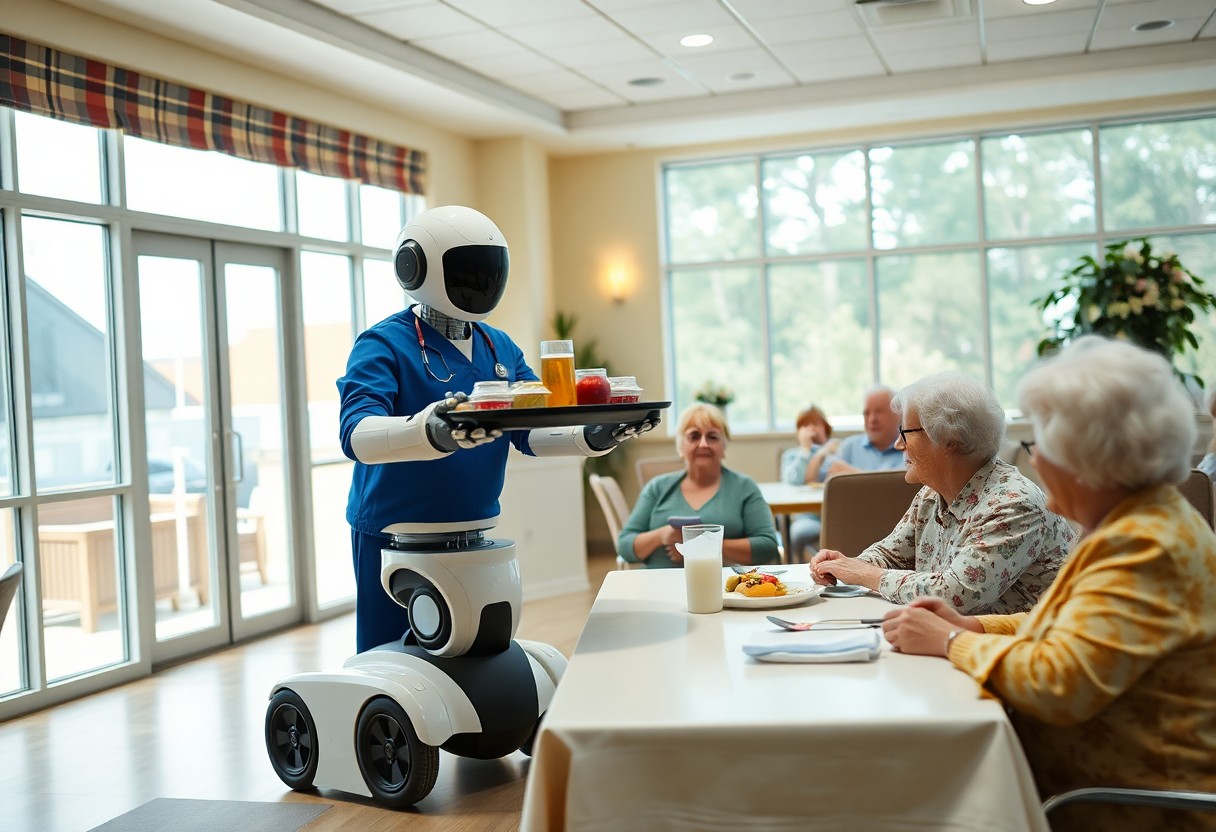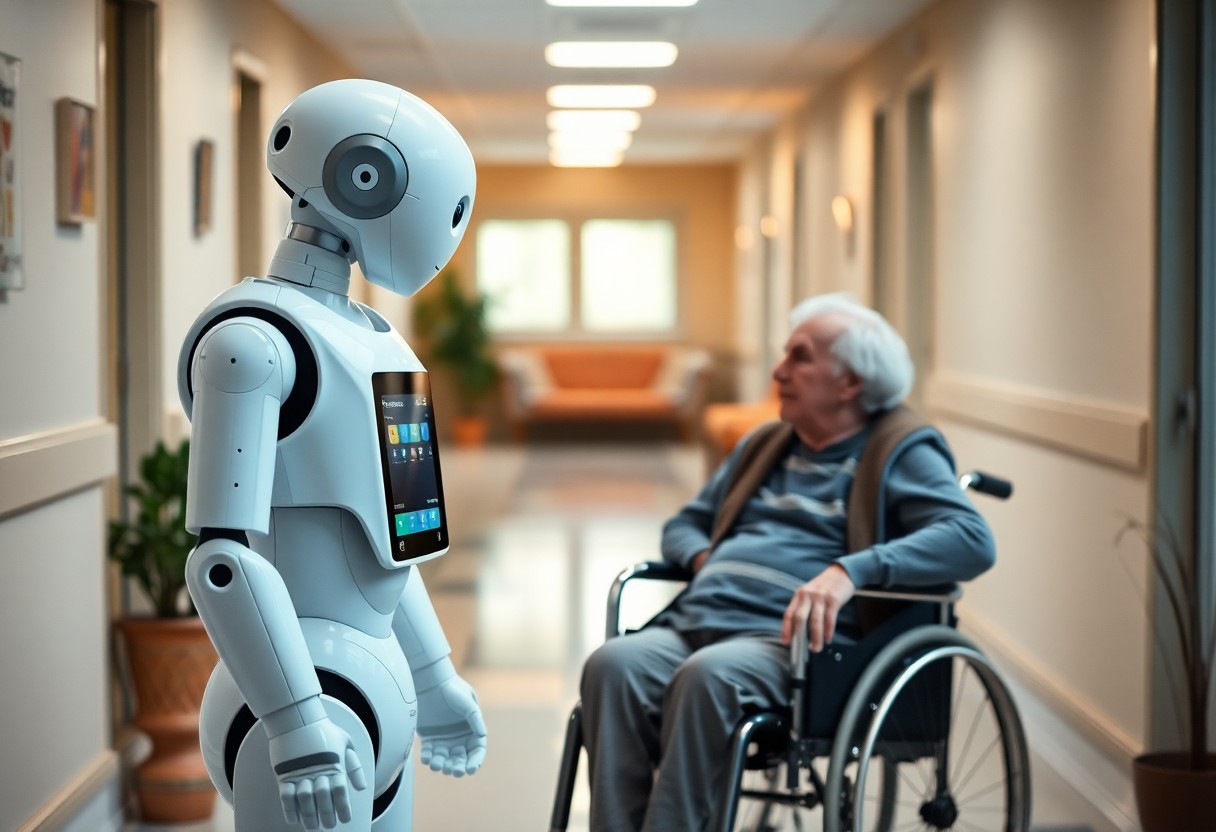Most nursing homes are now integrating care and assistive robots into their daily operations to enhance the quality of life for residents. These innovative technologies can assist you in various tasks, from medication management to providing companionship, ultimately allowing staff to focus more on personal interactions. By embracing this advancement, you can witness a transformation in how care is delivered, leading to improved efficiency and satisfaction among both residents and caregivers.
Overview of Care and Assistive Robots
Care and assistive robots are increasingly playing a vital role in nursing homes, enhancing the quality of life for residents and supporting staff efficiency. These robots assist with daily tasks, provide companionship, and help monitor health, making them indispensable assets in modern care facilities. Their integration not only improves care delivery but also alleviates some burdens faced by caregivers, ensuring a more holistic approach to elderly care.
Types of Robots Used in Nursing Homes
Various types of robots are utilized in nursing homes, each serving distinct functions to address the needs of residents and staff. These can include:
- Robots for medication management
- Companion robots providing social interaction
- Mobility aids to assist residents in moving
- Telepresence robots for remote consultations
- Cleaning robots to maintain hygiene
Thou will find that each type serves to enhance both the logistical and emotional aspects of care.
| Type of Robot | Functionality |
|---|---|
| Medication Robots | Dispense and manage medication schedules |
| Companion Robots | Provide social interaction and entertainment |
| Mobility Assistance Robots | Help residents with walking and stability |
| Telepresence Robots | Facilitate virtual visits with healthcare providers |
| Cleaning Robots | Assist in maintaining facility cleanliness |
Technological Advancements and Features
Advancements in robotics technology have led to the development of sophisticated features in care and assistive robots. Smart sensors, artificial intelligence, and machine learning enable these robots to adapt to individual resident needs, offering personalized support and improving interaction quality.
Innovations such as facial recognition, voice activation, and real-time health monitoring enhance the functionality of assistive robots. For example, robots equipped with AI can learn and respond to residents’ routines and emotional states, providing tailored companionship. Moreover, applications integrating telehealth capabilities allow for seamless communication with healthcare professionals, ensuring timely medical intervention. As this technology evolves, the potential for improved resident experience and operational efficiency continues to grow.
Benefits of Implementing Robots in Elderly Care
Incorporating robots into elderly care offers numerous advantages, from enhancing patient interactions to streamlining operational efficiency. These technologies are designed to assist with daily activities, monitor vital signs, and provide companionship, thereby improving the overall quality of care and the wellbeing of residents. By leveraging robotic support, nursing homes can create a more responsive, engaging, and safe environment for both staff and residents.
Enhancing Patient Care and Safety
Robots can assist in monitoring patient health metrics, alerting caregivers to any concerning changes in real-time. This proactive approach ensures faster responses to medical emergencies, enhancing safety and significantly reducing potential risks. Additionally, they can offer reminders for medication and appointments, helping you maintain adherence to treatment plans, ultimately leading to better health outcomes.
Reducing Workload for Nursing Staff
Utilizing robots in nursing homes alleviates many routine tasks from nursing staff, allowing them to focus more on direct patient care. For example, robots can manage medication distribution, assist in mobility, or perform regular check-ins with residents. Studies show that hospitals implementing robotics have seen up to a 30% increase in task efficiency, enabling staff to dedicate more time to complex care needs and emotional support, which are vital for patient satisfaction and overall wellness.
Challenges and Limitations
Despite the potential benefits, implementing care and assistive robots in nursing homes faces significant challenges and limitations. You must consider factors like cost, integration with existing systems, and staff training. Resistance from patients and staff can also create barriers to acceptance. For more insights, explore how robots in nursing homes can improve patient care while navigating these hurdles.
Technical and Operational Obstacles
Technical issues, such as system reliability and compatibility with other technologies, can hinder the effective use of robots in nursing homes. You might encounter challenges in ensuring seamless communication among devices and the training required for staff to operate them effectively. Additionally, the initial costs for purchasing and maintaining robots may pose a financial burden, impacting budget allocation.
Ethical Considerations and Acceptance
Ethical considerations surround the use of robots in care settings, including privacy concerns and the emotional well-being of elderly residents. You might see diverse reactions from patients and families regarding robot-assisted care, particularly about the loss of human interaction. Acceptance varies widely, necessitating conversations about autonomy and the role of technology in personal care.
The ethical implications of using robots in nursing homes extend beyond functionality to deeper questions about human connection. You may encounter feelings of disconnection from residents who prefer human caregivers. Concerns about data privacy also emerge, as robots might collect sensitive information about patients. Balancing efficiency with empathy is key; fostering an environment where both technology and human interaction coexist is imperative to ensure residents feel valued and cared for.
Case Studies and Real-World Applications
Your understanding of care and assistive robots is enriched by real-world implementations that highlight their impact in nursing homes. Numerous organizations have integrated these technologies, showcasing varying degrees of success and innovative solutions tailored to specific challenges.
- Misty Robotics in Iowa: A pilot program reduced fall incidents by 30% and improved staff workflow efficiency by 40% within three months.
- PARO Therapeutic Robot in Japan: Residents reported a 25% increase in emotional well-being and a 50% enhancement in social interaction over six months.
- robots at Silver Hill Hospital: Implemented robotic companions led to a 20% decrease in medication errors and a 15% faster recovery time for patients.
- Carebot in the UK: Utilized for routine check-ups and monitoring, achieving a 60% reduction in staff overtime hours.
Successful Implementations
Your observations of successful implementations reveal that well-designed care robots can significantly improve operational efficiencies and resident satisfaction. For instance, the use of robotic assistants in a nursing home in Florida increased resident engagement by 35%, illustrating how these technologies can foster socialization and enhance quality of life.
Lessons Learned from Failures
Analyzing failed implementations provides valuable insights into the pitfalls of integrating robots into nursing home settings. In various cases, insufficient training for staff and poor compatibility with existing workflows contributed to high abandonment rates and mistrust from residents.
One notable example involved a robotics company that launched a multi-functional care robot without adequate staff training. As a result, the care team struggled to adopt the technology, leading to a 50% dissatisfaction rate among both staff and residents within the first year. In this scenario, critical feedback highlighted that personal interaction remains crucial, and technology must serve to complement, rather than replace, human caregivers. Such failures underscore the need for thoughtful integration, involving hands-on training and ongoing support to foster acceptance and maximize effectiveness.
Future Trends in Care Robotics
The future of care robotics looks promising, with advancements focused on improving functionality, interactivity, and user-friendliness. As technology evolves, you can expect increased integration of artificial intelligence, enabling robots to learn and adapt to individual patient needs. Enhanced battery life and mobility solutions will further expand their utility in nursing homes, fostering a more supportive environment for both caregivers and residents.
Innovations on the Horizon
Emerging technologies will revolutionize the capabilities of care robots, providing even more personalized support. Innovations such as advanced natural language processing will enable robots to engage in more meaningful conversations with residents, helping to combat loneliness. Robotics with improved sensory perception will allow them to better monitor health conditions and assist with daily activities, elevating the quality of care you can expect in nursing homes.
Policy and Regulatory Landscape
The landscape surrounding the policy and regulation of care robots is rapidly evolving, necessitating a clear framework to ensure their safe implementation in nursing homes. You will likely see governments and regulatory bodies developing updated guidelines that address the ethical implications and safety standards of robotic integration in healthcare settings, ensuring compliance and transparency.
Current discussions around the policy and regulatory landscape are focused on establishing comprehensive guidelines that balance innovation with safety. For instance, the FDA has started to propose frameworks for assessing the functionality and risks of healthcare robots. These frameworks aim to facilitate smooth integration while ensuring that robots adhere to medical device standards. Collaboration between tech developers, healthcare professionals, and policymakers is imperative to create robust regulations that safeguard both residents and staff, paving the way for the widespread adoption of care robots in nursing homes. As you navigate this evolving landscape, staying informed about these developments will be imperative for making informed decisions regarding care robotics in your facility.

Training and Integration Strategies
Preparing Staff and Residents
You must prioritize comprehensive training for staff and residents before introducing robots. Effective workshops and demonstration sessions about robot functionalities can alleviate fears and build trust. Involving staff throughout the process ensures they feel empowered and informed, while engaging residents fosters comfort and acceptance, ultimately smoothing the transition and enhancing overall satisfaction.
Continuous Assessment and Improvement
Regular evaluation of robot performance and user satisfaction allows you to identify areas for improvement and adjust training protocols accordingly. Gathering feedback from both staff and residents ensures that the integration is continuously refined to meet evolving needs.
Continuous assessment involves not only monitoring robot efficacy but also assessing user interactions and experiences. Implementing surveys and focus groups will provide valuable insights into how well the robots are serving their intended purpose. For example, tracking engagement levels or collecting qualitative feedback on personal experiences can highlight specific challenges, allowing for an agile response. Adjustments to training or operation protocols based on real-time data ensure that both staff and residents derive maximum benefits from the technology, leading to a more effective caregiving environment. This iterative process fosters an adaptable ecosystem that keeps pace with changing needs in the nursing home setting.
Summing up
Presently, care and assistive robots in nursing homes enhance your experience by providing support in daily tasks and improving the quality of life for residents. These technologies enable you to maintain independence while ensuring that necessary care is readily available. As these innovations continue to evolve, you can expect increased efficiency, personalized care, and improved emotional well-being for you and your loved ones in nursing home settings.







